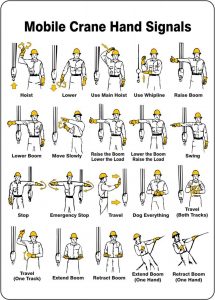
Having a competent signalperson directing the crane is just as important as having a competent crane operator sitting at the controls of the crane.
Under the current OSHA crane standard there are only select instances when a signalperson is not required and for all those other times; having a top flight signalperson should be a priority.
Using standard hand signals is the most widely used manner of signaling a crane operator. A hand signal chart can usually be found on the side of the crane or it should be conspicuously posted in the vicinity of where hoisting operations are being conducted.
Radio communication, or other means of electronic communication with a crane operator is acceptable as well but when using electronic means to communicate it must be: through a dedicated channel (unless multiple cranes are used or there is more than one signalperson being used to coordinate operations); when a crane is being operated on or adjacent to railroad tracks, and the actions of the crane operator need to be coordinated with the movement of trains or other equipment; and, the crane operator’s reception of signals must be by a hands free system.
New signals can be given to the crane operator but they must be agreed upon beforehand by the crane operator(s), signalperson(s) and lift director (if one is used).
Any time crane operations require a signalperson, communication between the crane operator and signalperson must be maintained at all times. In the event these two can’t communicate; the crane operator should safely stop all crane operations until communications with the signalperson can be re-established. Remember too, that only one person may give signals to the crane operator at a time, but anyone who becomes aware of a safety problem must alert the crane operator or signalperson by giving the emergency stop signal.
Feel free to print and study the universal mobile crane hand signals chart below.



